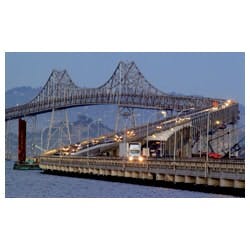The Richmond-San Rafael Bridge
The Richmond-San Rafael bridge sits in between perhaps the most dangerous and sensitive zone for an elevated structure in the world. It’s just 4 miles from the Hayward Fault and 10 miles from the infamous San Andreas Fault. When the time came for strengthening, Caltrans created an entire new volume of how to seismically retrofit a major bridge. The $467 million project, which was just completed in September, was the obvious choice for ROADS & BRIDGES’ No. 1 bridge project in 2005. The chance of corrosion or weakening over the next 100 years appear to be slim.
“It’s really elaborate on how this bridge got retrofit,” Craig Chatelain, project manager for DMJM Harris, told ROADS & BRIDGES. DMJM Harris is part of an engineering joint venture with Sverdrup and Ben C. Gerwick Inc. Chatelain, however, was in charge of the one exception to the project, and it was equally impressive. Rather than going with a retrofit, Caltrans thought it was best to replace the western trestle spans of the Richmond-San Rafael. The job was full of challenges, which in turn created a load of ingenuity.
The contractor—a joint venture of Tutor-Saliba Corp., Sylmar, Calif., Koch Skanska USA, Carteret, N.J., and Tidewater Construction Corp., Norfolk, Va.—was able to conduct eight-hour nighttime closures, but much of the work was done under traffic.
